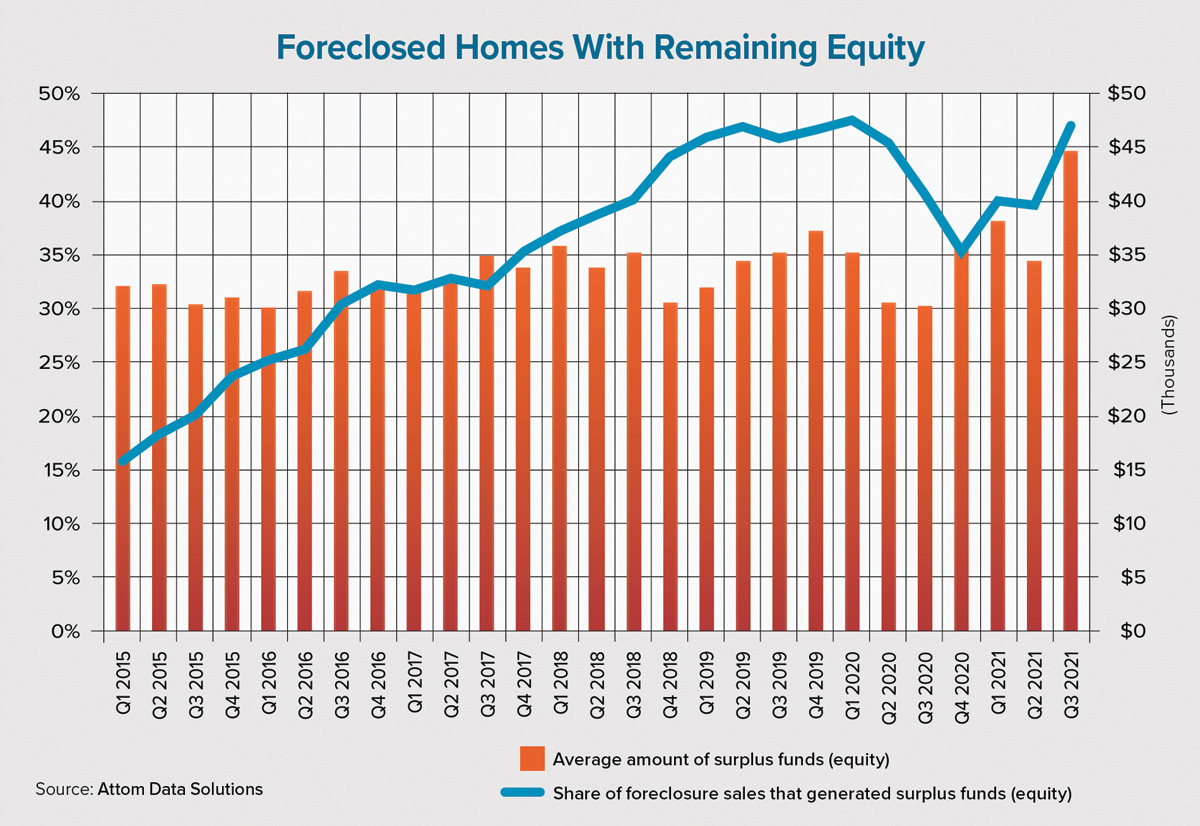The unprecedented amount of equity in the U.S. housing market has become the go-to data point for many who predict that the spike in mortgage delinquencies and loans in forbearance caused by the COVID-19 pandemic won’t result in a massive wave of foreclosures. But recent analysis from Black Knight, along with proprietary data from the Auction.com marketplace, suggest that there may be some holes in the home equity safety net.
Black Knight’s analysis, included in its August 2021 Mortgage Monitor report, looked at the rate of debtholders who became delinquent on their mortgage payments or what is called roll rates. The analysis looked at the loans that went from seriously delinquent status to foreclosure starts, as well as the roll rates from foreclosure starts to involuntary liquidations of a home — typically via short sale, foreclosure sale or deed in lieu of foreclosure.
The analysis broke down these two roll rates into six home equity buckets, ranging from homes with at least 40% equity to homes with negative equity. The roll rates in each home equity bucket were tracked for each year back to 2007.
It’s rational to expect that a homeowner with equity would choose to sell rather than lose his or her home to foreclosure. A preforeclosure equity sale allows the homeowner to walk away with cash while avoiding a hit to their credit score. But the Black Knight analysis paints a more nuanced picture in which people do not always behave rationally.
First, the amount of home equity appears to have no significant impact on the shares of loans that went from being seriously delinquent to foreclosure starts, at least over the past decade. “While homeowners with limited equity were much more likely to be referred to foreclosure during the early stages of the Great Recession, start rates on 120-plus-day delinquencies have been relatively similar regardless of equity position from 2010 on,” the report states.
Second, while home equity makes a difference in the roll rates from foreclosure start to involuntary liquidation — high equity borrowers are about half as likely to face the involuntary liquidation of their home as borrowers with the weakest equity positions — even borrowers with the most equity have a relatively high roll rate. Black Knight’s analysis concluded that even among homeowners with combined loan-to-value ratios of less than 60%, three in 10 who started the foreclosure process ultimately faced involuntary liquidation. This suggests that many who could have completed a traditional sale rather than losing their home to foreclosure chose the latter route.
This behavior on the part of distressed homeowners may be surprising from a classic economics perspective, which assumes that people will act rationally. But it does align with a basic tenant of behavioral economics — that people do not always make rational or optimal decisions because of psychological factors such as overconfidence, loss aversion and self-control.
The Black Knight analysis reinforces some perplexing data from the Auction.com marketplace, which found that 45% of all properties purchased by third-party buyers at foreclosure auctions over the past three years have sold for more than the total debt owed to the foreclosing lender. These excess proceeds from foreclosure auctions are known as surplus funds. They represent potential home equity that is distributed back to the foreclosed homeowner after any junior liens are paid.
The share of foreclosure sales with surplus funds dipped during the early stages of the pandemic and bottomed out at 35% in fourth-quarter 2020 but has since rebounded to a new pandemic- era high of 47% as of third-quarter 2021. The average amount of surplus funds in Q3 2021 was $44,659, the highest figure in more than eight years. It’s puzzling that such a high share of completed foreclosures are tied to homes that may have enough equity to prevent foreclosure through activities that are not a short sale.
The silver lining in this data? It demonstrates that a transparent, competitive foreclosure marketplace protects equity for distressed homeowners who may not even know that their property has it. Prior to the existence of robust foreclosure marketplaces, properties could be pushed through the foreclosure-auction process with little visibility to potential buyers. And once distressed properties revert to the foreclosing lender at auction, the distressed homeowner has no opportunity to recoup any equity found in the home through a subsequent resale. ●
-
Daren Blomquist is vice president of market economics at Auction.com. In this role, Blomquist analyzes and forecasts complex macroeconomic and microeconomic data trends to provide value to both buyers and sellers using the platform. Blomquist has been cited by thousands of media outlets nationwide, including major news networks, The Wall Street Journal, The New York Times and USA Today. Prior to Auction.com, Blomquist worked at Attom Data Solutions.
View all posts





